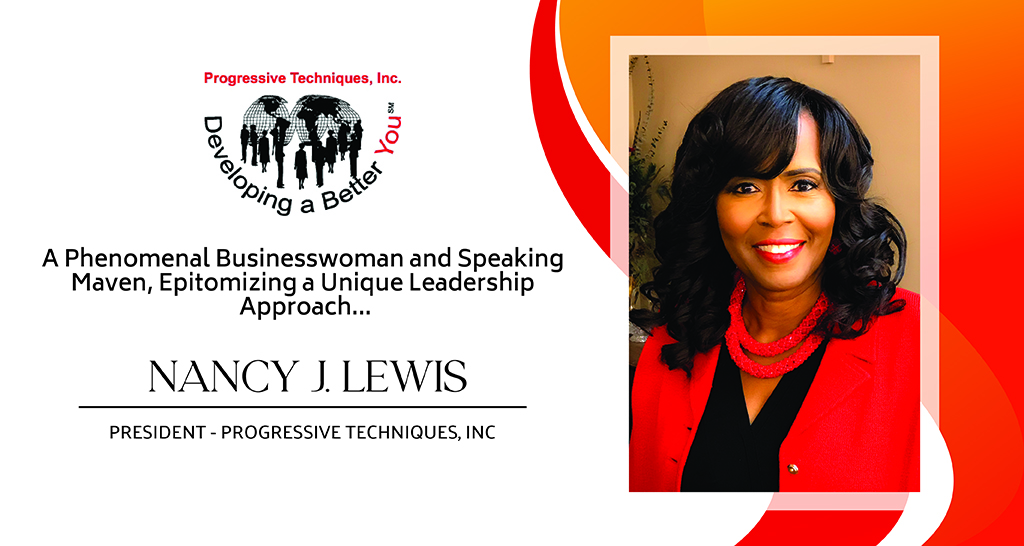Women around the world are succeeding exceptionally well in the business realm. They are fighting against everything with the greatest gallantry, despite the sea of obstacles. To reach the pinnacle, they are giving their hearts and souls to their task. Nancy J. Lewis is one of the finest examples of female leadership in this context. She is the proud president of Progressive Techniques, Inc., a prominent motivational and inspirational keynote speaker, trainer, author, and executive/business coach. With unwavering determination, she is thriving in the business sphere.
Excursions of a Business Leader
Nancy’s professional trajectory has been full of growth, obstacles, and surprises, with highs and lows along the way. Speaking on her early years, the inspirational woman revealed that she began her career in Atlanta, Georgia, as a Medical Technologist with the American Red Cross. After obtaining her Specialist in Blood Banking (SBB) certification, she was able to enter the speaking profession. This was a challenging season with many hurdles and barriers that compelled Nancy to change. By the grace of God, the aspiring lady was able to keep going through several difficult and painful lessons.
“Was it easy? Absolutely not! However, you should never give up on your destiny and the task that God has placed on your life. God knows, even when you do not know where to go next. Many spiritual lessons were discovered! Obedience and listening to God are crucial! That will spare you a great deal of unnecessary suffering during your travels,” remarked Nancy.
She was fortunate to be hired by a large firm as a sales support representative, which commenced her speaking journey. She enrolled in the Dale Carnegie Course shortly after, and everything else fell into place. She came to see that God had given her the ability to captivate and enthrall listeners with the passion and energy she emitted. A few years later after rigorous certification training, Nancy became an adjunct Dale Carnegie Instructor. This served as the foundation for her full-time speaking career. She worked in quite a few other industries before taking the full-time leap into the entrepreneurial world.
Insights of the Company
The renowned professional development and leadership training institution, Progressive Techniques, Inc. (PTI), empowers the clients to thrive in the rapidly evolving workplace. PTI helps CEOs and their leadership teams reach their full potential and follow their dreams by offering executive and business coaching. This is part of the team’s ongoing effort to enhance organizations. Intentional leadership, emotional intelligence, diversity and inclusion, unconscious bias, communication, change management, and career development workshops are a few of the primary topics covered in management and professional development courses. PTI also provides executive and business coaching to CEO’s and their leadership teams.
PTI’s creative and committed team brings top-notch energy, communication, and specialized training sessions for the workplace. They provide sensible and effective solutions for today’s intricate and evolving workplace.
The key different factors that make PTI stand out are that it brings joy to the workplace, energy, and real solutions in a post-covid workplace. The team is dedicated to sharing true experiences of struggle and triumph because they offer valuable lessons for succeeding in the workplace. A further significant aspect is their unwavering goal of producing better leaders.
PTI is one of Transforming Women Entrepreneurs’ (TWE) co-founders. Every year, they host a conference for business professionals and entrepreneurs in prestigious venues in the metro Atlanta area. Additionally, PTI is the sponsor of Conversations with Nancy J., their weekly television program aired on WATC TV 57.
The Industry Hurdles: Key Highlights
- Having a genuine knowledge of equity, diversity, . inclusion, and belonging.
- Navigating the workplace in a post-covid world.
- Leading in a hybrid and remote workplace.
- Mental health and wellness.
- Creating psychologically safe workplaces.
- Recruiting and retaining employees.
Building a Robust Network of Business Coaches
PTI’s business includes executive and business coaching as we understand the necessity of coaching in today’s workplace. Today’s leaders and workers face a plethora of personal and professional challenges, and navigating the evolving workplace requires them to collaborate with a knowledgeable and capable coach. PTI also sponsors a weekly television broadcast, featuring ordinary people doing EXTRAordinary things who share their testimonies and stories to empower, equip, and engage the audience to achieve more in their lives and careers.
Insights on the Gender Pay Gap: A Major Issue
“We have a long way to go to get equity,” quoted Nancy. Dismantling the systemic systems that contribute to these disparities is necessary. Women need to have the confidence and strength to ask for what they believe they deserve. There will be difficulties, but miracles and change cannot occur if people are unwilling to take chances and get out of the boat.
Future Outlook
Nancy’s journey serves as an inspiration for the strength of perseverance, passion, and creativity. And the numerous appreciations and recognitions she has earned reflect her dedication to making a positive impact. In the future, she plans to keep building and expanding the company by adding new online programs and courses that will enable contract trainers to work for PTI. She wishes to keep prayerfully growing the television broadcast. On the personal levels, Nancy’s future goals are to continue to serve and be active in ministry, enjoy life and the entrepreneurial journey, travel, and make a difference in the lives she touches!

